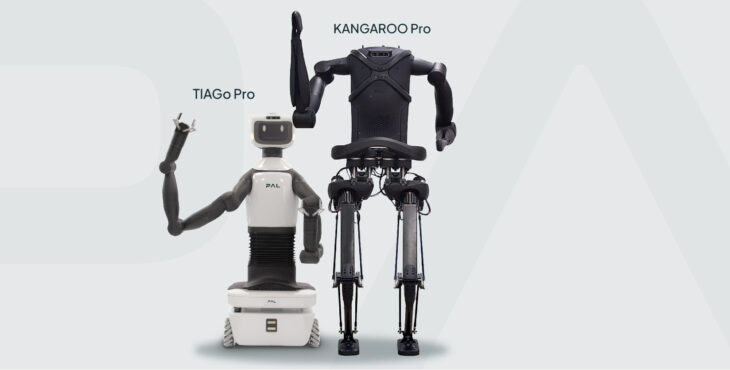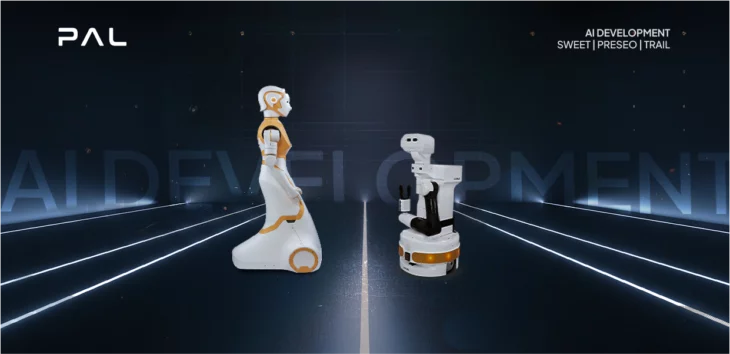TIAGo Base AI is the latest generation of Autonomous Mobile Robots by PAL Robotics. This base is designed for research on automation in industry, warehouse, retail, healthcare and office environments, and includes state-of-the-art software and sensors to navigate complex environments and fit a wide range of applications.
In contrast with other mobile bases, this new generation comes with a set of new features that improve several capabilities, including a vision system that integrates from the get-go two high-technology RGB-D cameras and a 245º wide FoV LiDAR, ensuring 3D environment perception and rich data collection.
TIAGo Base AI navigates in any environment thanks to its autonomous mapping and navigation SLAM system, including path planning and obstacle detection. Furthermore, the Advanced Navigation Suite provides obstacle avoidance by using the RGB-D cameras, the addition of virtual obstacles, topological localization based on Regions of Interest and the setting of preferential routes to navigate.
LIDAR sensors integrated for precise distance determination and more
TIAGo Base AI integrates one LiDAR (Light Detection and Ranging)sensor. These sensors are devices used in robotics and other applications to measure distances and create two-dimensional representations of the environment using laser pulses. LiDAR sensors emit bursts of laser light and measure the time it takes to reflect off the surrounding objects, allowing for precise distance determination.
In addition to measuring distances, LiDAR sensors provide information about the shape and geometry of objects within their field of view by scanning the environment in multiple directions, generating two-dimensional point clouds that accurately represent the structure of the objects, but the advantages of LIDAR sensors go beyond this, this technology is also used to create detailed 2D maps of the environment in real-time as the robot moves thanks to the combination of LiDAR data with other sensors such as odometry from the wheels’ encoders. During autonomous navigation, the LiDAR data is used to calculate a more robust odometry and compared to the map to help localise the robot.
The ability of this technology to precisely measure distances and generate detailed representations of the environment makes it an essential tool for perception and decision-making in autonomous environments, Furthermore these sensors play a key role in mobile robotics applications, such as healthcare, as they enable the detection and tracking of a specific target, allowing mobile robots to interact and perform specific tasks such as assisting older people in their homes.
Even Though LIDAR sensor technology is very helpful for mapping and self-positioning it has some limitations as it can’t detect 3D objects as the laser actuates in a 2D plane, to overcome this limitation TIAGo Base AI base also includes integrated RGB-D cameras.
RGB-D camera for depth vision, including 3D objects detection
RGB-D (Red-Green-Blue Depth) cameras are devices that combine a traditional RGB camera with a depth sensor. These cameras capture both colour information and depth information in a single shot. Unlike conventional cameras, which only record two-dimensional information, RGB-D cameras provide a three-dimensional representation of the environment.
In summary, the main utility of RGB-D cameras in robotics lies in their ability to capture and understand the environment in three dimensions. The depth sensor provides information about the distance between the sensor and the surrounding objects within a certain volume in front of the sensor, allowing robots to perceive and understand the spatial structure of their environment more accurately. This capability significantly enhances autonomous navigation, interaction with humans, and object manipulation, opening the door to a wide range of robotic applications in various fields.
Furthermore, thanks to the integrated NVIDIA Jetson GPU of TIAGo Base AI you can take the most out of the data provided by the cameras using cutting-edge AI algorithms.

TIAGo Base AI, the latest generation of autonomous mobile bases
TIAGo Base AI is able to carry payloads of up to 150kg in any indoor environment, including those with harsh conditions thanks to the built-in high-quality insulation system that protects the onboard electronic components from possible water remaining on the floor. The robot allows you to maintain excellent balance by using its newly improved suspension system. Additionally, the mobile baseautomatically goes to the dock station to recharge its batteries thanks to the robot’s latest generation software which comes with automatic charging.
TIAGo Base AI was developed as a result of the SCAFo project, the main objective of this project was to facilitate the introduction of a fleet of AMRs based on developments to the established TIAGo Base robot model to perform food transportation tasks in the unstructured and dynamic environment of the food processing industry. The solution addresses all the relevant key abilities needed by service robots in the market today for semi- or full autonomy in an environment collaborating together with human workers. If you want to know more about the role TIAGo Base AI played in the SCAFo project, check out this video.
To learn more about TIAGo Base AI and our family of AMRs visit our website. If you would like to ask us more, get in touch with us.
- AMR
- Industry 4.0
- Intralogistics
- Navigation
- TIAGo Base AI


